air suspension INFINITI QX80 2021 Owner's Manual
[x] Cancel search | Manufacturer: INFINITI, Model Year: 2021, Model line: QX80, Model: INFINITI QX80 2021Pages: 529, PDF Size: 2.05 MB
Page 3 of 529
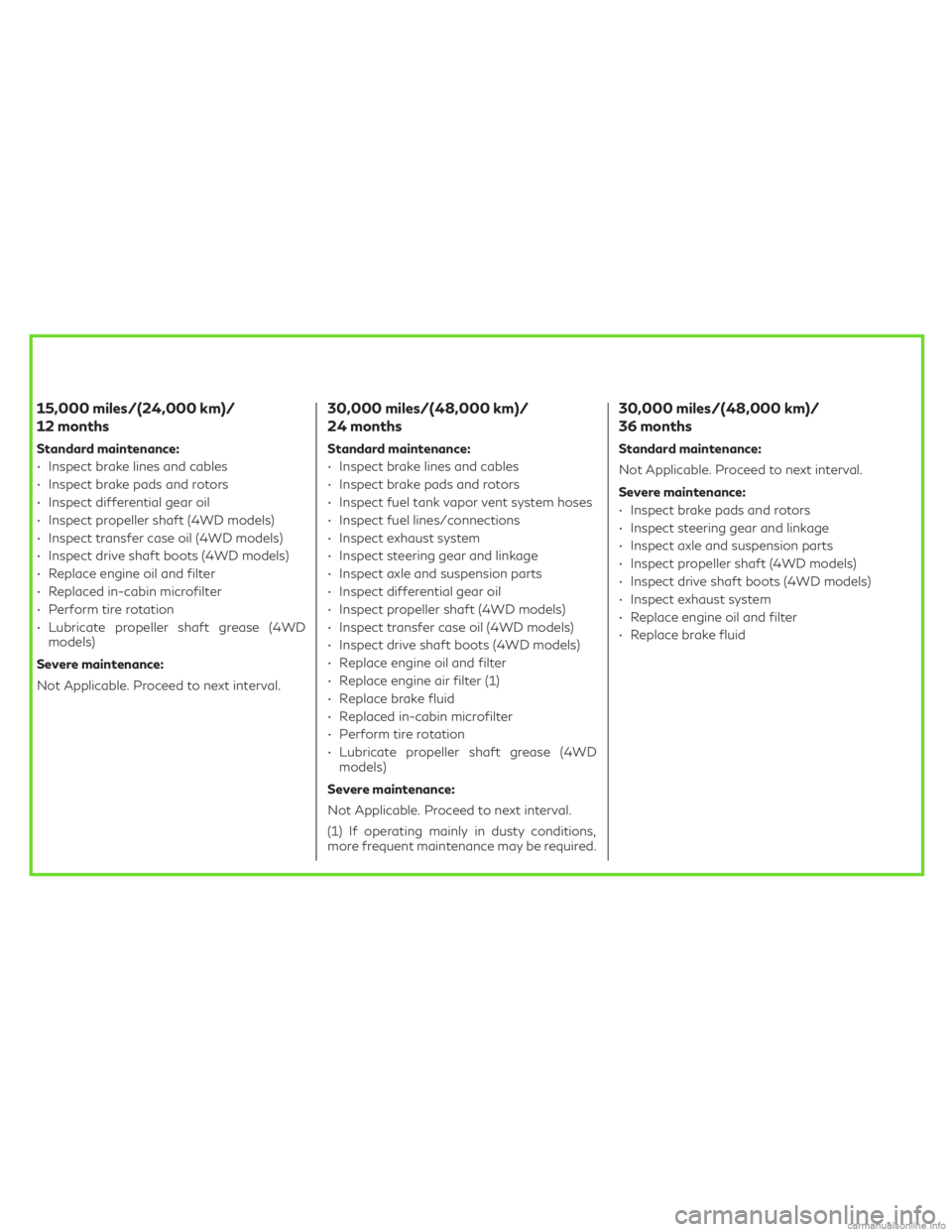
15,000 miles/(24,000 km)/
12 months
Standard maintenance:
• Inspect brake lines and cables
• Inspect brake pads and rotors
• Inspect differential gear oil
• Inspect propeller shaft (4WD models)
• Inspect transfer case oil (4WD models)
• Inspect drive shaft boots (4WD models)
• Replace engine oil and filter
• Replaced in-cabin microfilter
• Perform tire rotation
• Lubricate propeller shaft grease (4WD
models)
Severe maintenance:
Not Applicable. Proceed to next interval.
30,000 miles/(48,000 km)/
24 months
Standard maintenance:
• Inspect brake lines and cables
• Inspect brake pads and rotors
• Inspect fuel tank vapor vent system hoses
• Inspect fuel lines/connections
• Inspect exhaust system
• Inspect steering gear and linkage
• Inspect axle and suspension parts
• Inspect differential gear oil
• Inspect propeller shaft (4WD models)
• Inspect transfer case oil (4WD models)
• Inspect drive shaft boots (4WD models)
• Replace engine oil and filter
• Replace engine air filter (1)
• Replace brake fluid
• Replaced in-cabin microfilter
• Perform tire rotation
• Lubricate propeller shaft grease (4WD
models)
Severe maintenance:
Not Applicable. Proceed to next interval.
(1) If operating mainly in dusty conditions,
more frequent maintenance may be required.
30,000 miles/(48,000 km)/
36 months
Standard maintenance:
Not Applicable. Proceed to next interval.
Severe maintenance:
• Inspect brake pads and rotors
• Inspect steering gear and linkage
• Inspect axle and suspension parts
• Inspect propeller shaft (4WD models)
• Inspect drive shaft boots (4WD models)
• Inspect exhaust system
• Replace engine oil and filter
• Replace brake fluid
Page 4 of 529
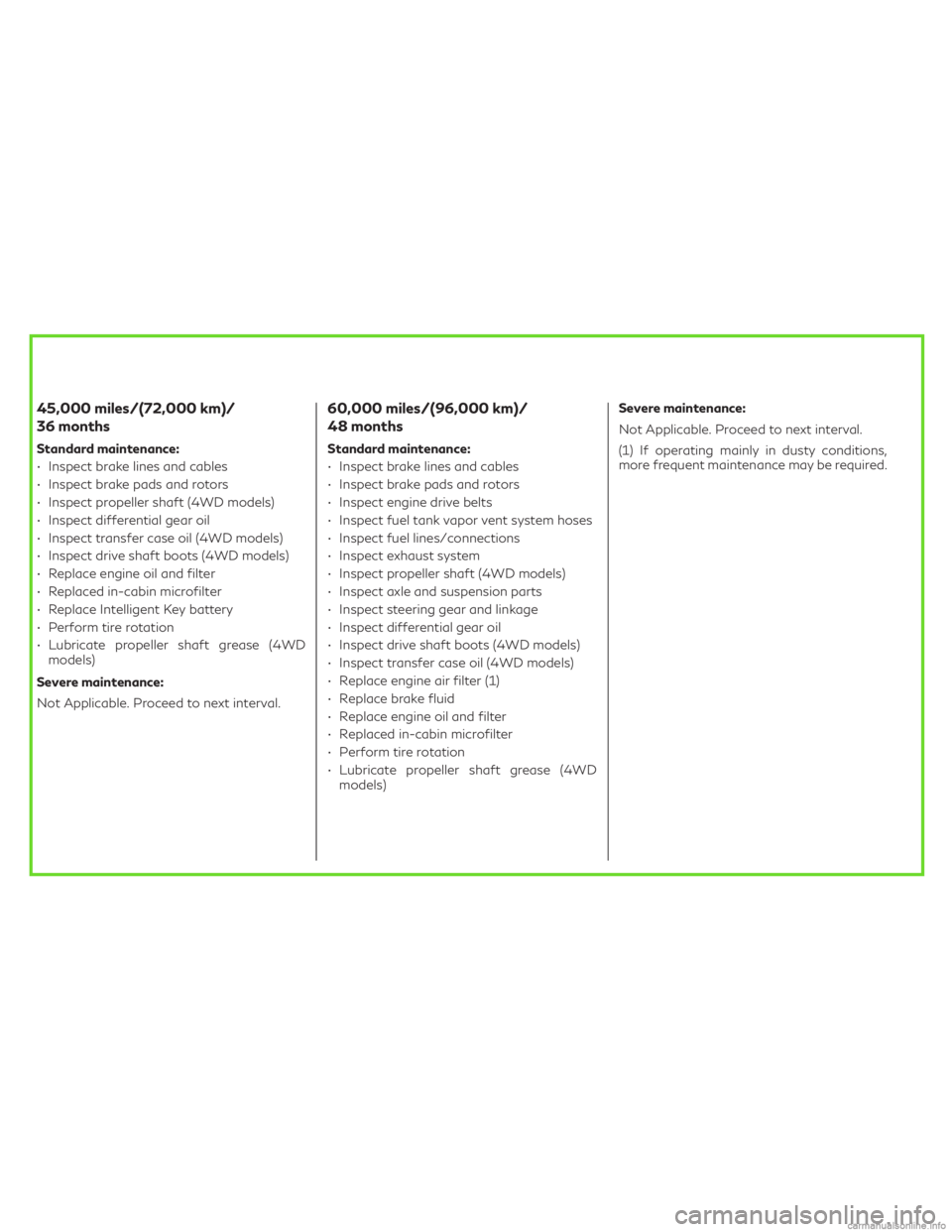
45,000 miles/(72,000 km)/
36 months
Standard maintenance:
• Inspect brake lines and cables
• Inspect brake pads and rotors
• Inspect propeller shaft (4WD models)
• Inspect differential gear oil
• Inspect transfer case oil (4WD models)
• Inspect drive shaft boots (4WD models)
• Replace engine oil and filter
• Replaced in-cabin microfilter
• Replace Intelligent Key battery
• Perform tire rotation
• Lubricate propeller shaft grease (4WD
models)
Severe maintenance:
Not Applicable. Proceed to next interval.
60,000 miles/(96,000 km)/
48 months
Standard maintenance:
• Inspect brake lines and cables
• Inspect brake pads and rotors
• Inspect engine drive belts
• Inspect fuel tank vapor vent system hoses
• Inspect fuel lines/connections
• Inspect exhaust system
• Inspect propeller shaft (4WD models)
• Inspect axle and suspension parts
• Inspect steering gear and linkage
• Inspect differential gear oil
• Inspect drive shaft boots (4WD models)
• Inspect transfer case oil (4WD models)
• Replace engine air filter (1)
• Replace brake fluid
• Replace engine oil and filter
• Replaced in-cabin microfilter
• Perform tire rotation
• Lubricate propeller shaft grease (4WD
models)Severe maintenance:
Not Applicable. Proceed to next interval.
(1) If operating mainly in dusty conditions,
more frequent maintenance may be required.
Page 5 of 529
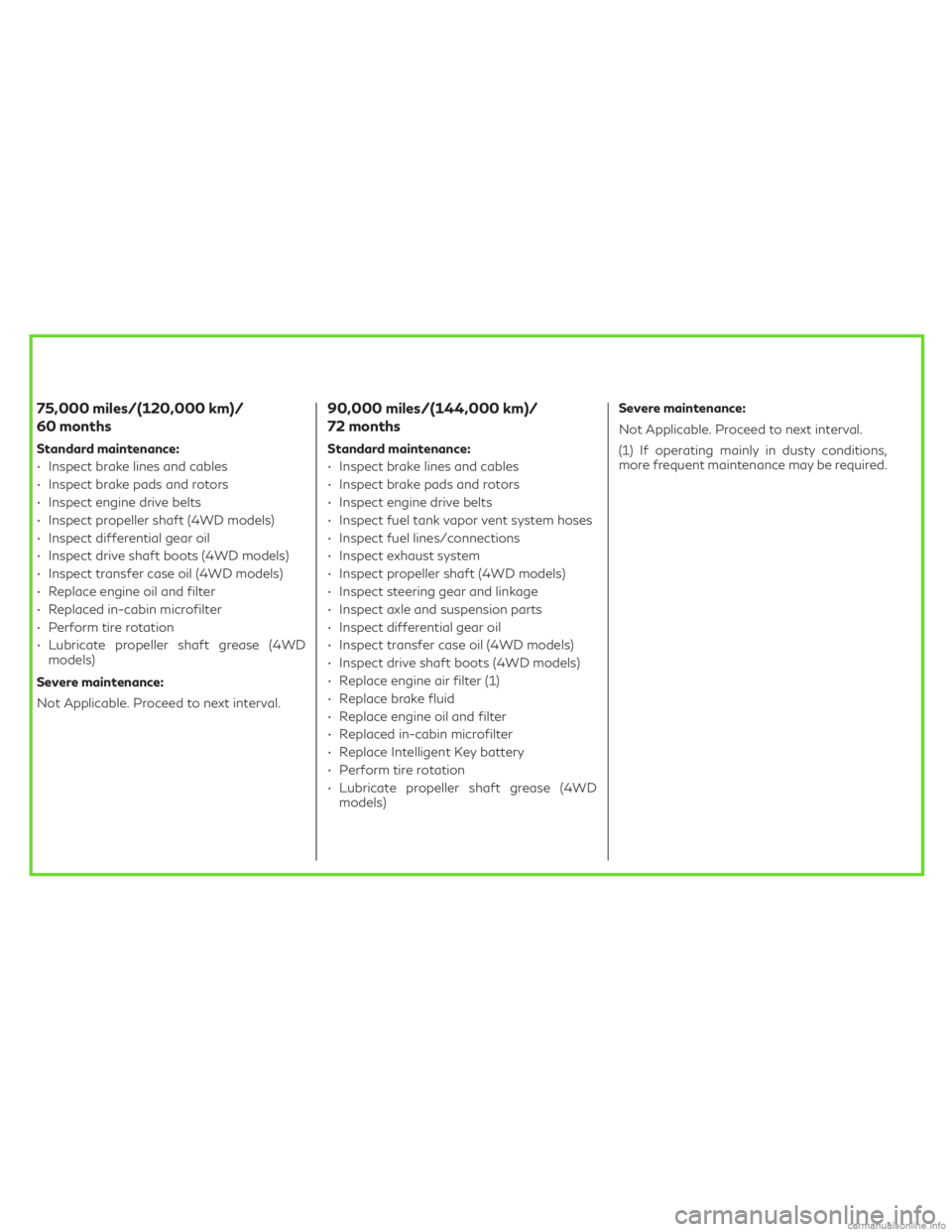
75,000 miles/(120,000 km)/
60 months
Standard maintenance:
• Inspect brake lines and cables
• Inspect brake pads and rotors
• Inspect engine drive belts
• Inspect propeller shaft (4WD models)
• Inspect differential gear oil
• Inspect drive shaft boots (4WD models)
• Inspect transfer case oil (4WD models)
• Replace engine oil and filter
• Replaced in-cabin microfilter
• Perform tire rotation
• Lubricate propeller shaft grease (4WD
models)
Severe maintenance:
Not Applicable. Proceed to next interval.
90,000 miles/(144,000 km)/
72 months
Standard maintenance:
• Inspect brake lines and cables
• Inspect brake pads and rotors
• Inspect engine drive belts
• Inspect fuel tank vapor vent system hoses
• Inspect fuel lines/connections
• Inspect exhaust system
• Inspect propeller shaft (4WD models)
• Inspect steering gear and linkage
• Inspect axle and suspension parts
• Inspect differential gear oil
• Inspect transfer case oil (4WD models)
• Inspect drive shaft boots (4WD models)
• Replace engine air filter (1)
• Replace brake fluid
• Replace engine oil and filter
• Replaced in-cabin microfilter
• Replace Intelligent Key battery
• Perform tire rotation
• Lubricate propeller shaft grease (4WD
models)Severe maintenance:
Not Applicable. Proceed to next interval.
(1) If operating mainly in dusty conditions,
more frequent maintenance may be required.
Page 6 of 529
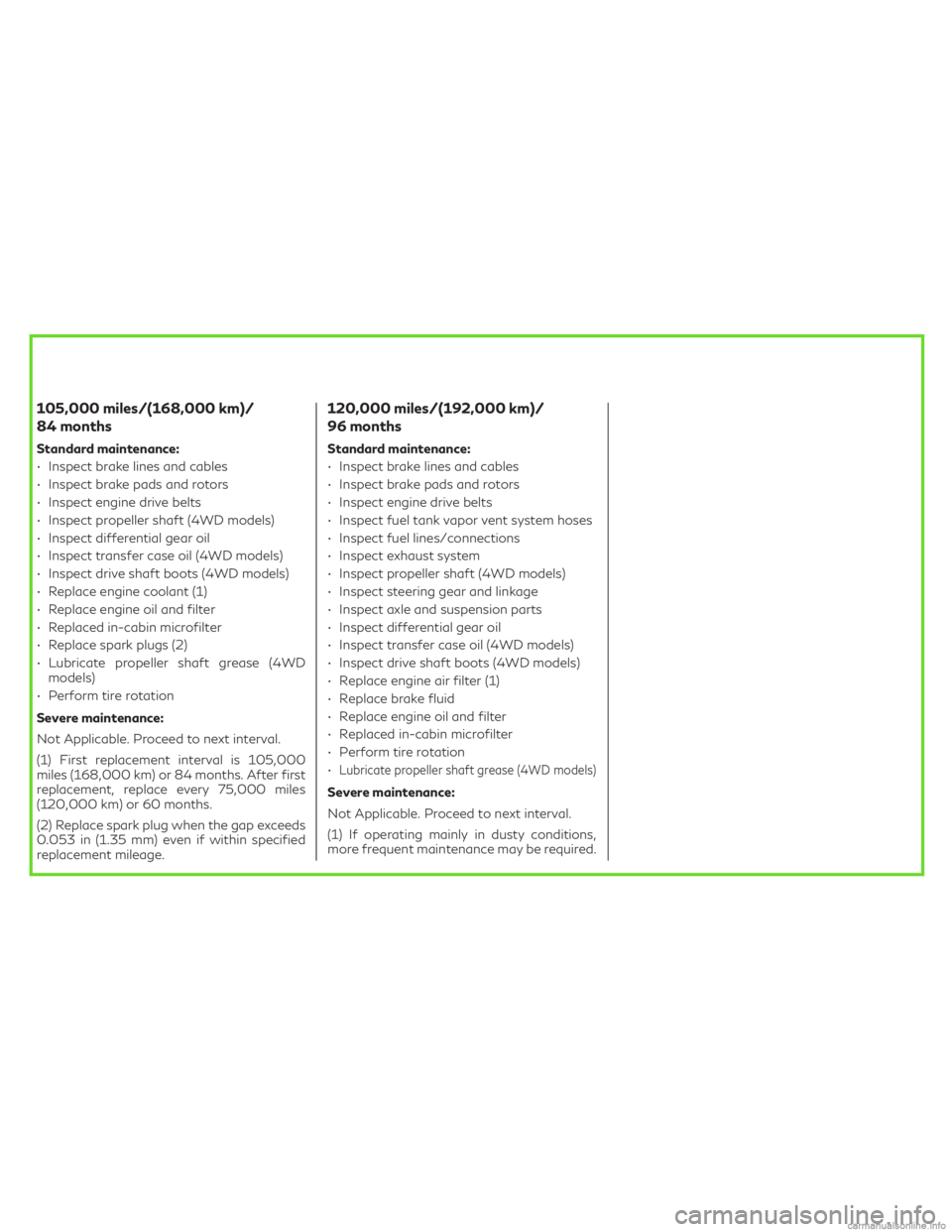
105,000 miles/(168,000 km)/
84 months
Standard maintenance:
• Inspect brake lines and cables
• Inspect brake pads and rotors
• Inspect engine drive belts
• Inspect propeller shaft (4WD models)
• Inspect differential gear oil
• Inspect transfer case oil (4WD models)
• Inspect drive shaft boots (4WD models)
• Replace engine coolant (1)
• Replace engine oil and filter
• Replaced in-cabin microfilter
• Replace spark plugs (2)
• Lubricate propeller shaft grease (4WD
models)
• Perform tire rotation
Severe maintenance:
Not Applicable. Proceed to next interval.
(1) First replacement interval is 105,000
miles (168,000 km) or 84 months. After first
replacement, replace every 75,000 miles
(120,000 km) or 60 months.
(2) Replace spark plug when the gap exceeds
0.053 in (1.35 mm) even if within specified
replacement mileage.
120,000 miles/(192,000 km)/
96 months
Standard maintenance:
• Inspect brake lines and cables
• Inspect brake pads and rotors
• Inspect engine drive belts
• Inspect fuel tank vapor vent system hoses
• Inspect fuel lines/connections
• Inspect exhaust system
• Inspect propeller shaft (4WD models)
• Inspect steering gear and linkage
• Inspect axle and suspension parts
• Inspect differential gear oil
• Inspect transfer case oil (4WD models)
• Inspect drive shaft boots (4WD models)
• Replace engine air filter (1)
• Replace brake fluid
• Replace engine oil and filter
• Replaced in-cabin microfilter
• Perform tire rotation
•
Lubricate propeller shaft grease (4WD models)
Severe maintenance:
Not Applicable. Proceed to next interval.
(1) If operating mainly in dusty conditions,
more frequent maintenance may be required.
Page 27 of 529

0-14Illustrated table of contents
Red lightNamePage
Automatic Transmission (AT)
oil temperature warning light 2-12
Automatic Transmission (AT)
park warning light2-12
Brake warning light
2-12
Charge warning light 2-13
Engine oil pressure warning
light2-13
Master warning light 2-14
Seat belt warning light 2-14
Security indicator light 2-14
Supplemental air bag warn-
ing light2-14Yellow
light Name Page
Adaptive Front lighting Sys-
tem (AFS) indicator light (if so
equipped) 2-15
Anti-lock Braking System
(ABS) warning light
2-15
Automatic Transmission (AT)
check warning light2-15
Check suspension indicator
light2-15
Four-Wheel Drive (4WD)
warning light (4WD models)
2-15
Forward Emergency Braking
(FEB) system warning light2-16
Low tire pressure warning
light
2-16
Malfunction Indicator Light
(MIL) 2-17
Master warning light 2-18
Vehicle Dynamic Control
(VDC) off indicator light2-18
Vehicle Dynamic Control
(VDC) warning light
2-18Other
light Name Page
Exterior light indicator
2-19
Front fog light indicator light2-19
Front passenger air bag sta-
tus light2-19
High beam assist indicator
light
2-19
High beam indicator light
2-19
TOW mode indicator light 2-19
Turn signal/hazard indicator
lights2-19
WARNING AND INDICATOR LIGHTS
Page 91 of 529
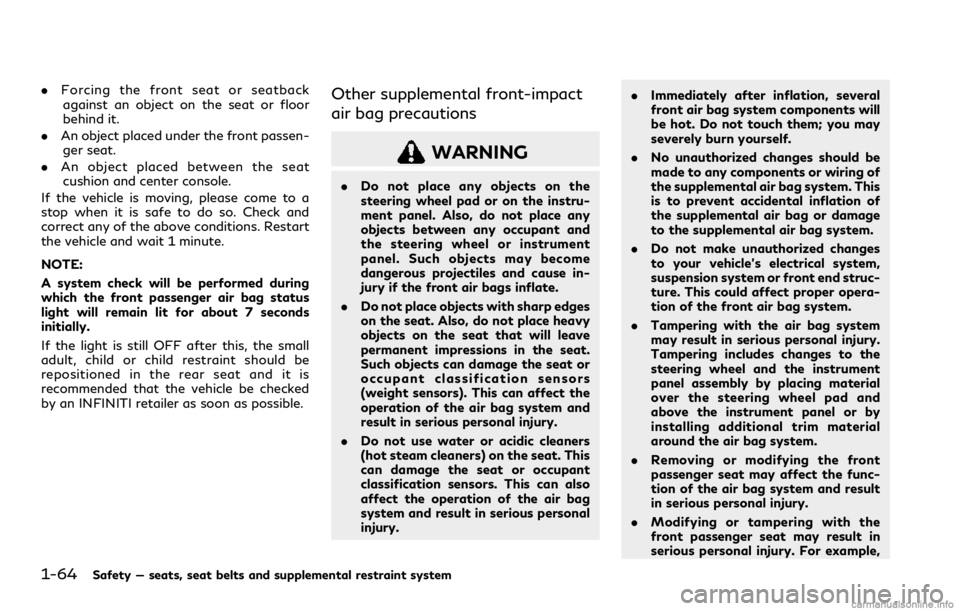
1-64Safety — seats, seat belts and supplemental restraint system
.Forcing the front seat or seatback
against an object on the seat or floor
behind it.
. An object placed under the front passen-
ger seat.
. An object placed between the seat
cushion and center console.
If the vehicle is moving, please come to a
stop when it is safe to do so. Check and
correct any of the above conditions. Restart
the vehicle and wait 1 minute.
NOTE:
A system check will be performed during
which the front passenger air bag status
light will remain lit for about 7 seconds
initially.
If the light is still OFF after this, the small
adult, child or child restraint should be
repositioned in the rear seat and it is
recommended that the vehicle be checked
by an INFINITI retailer as soon as possible.Other supplemental front-impact
air bag precautions
WARNING
. Do not place any objects on the
steering wheel pad or on the instru-
ment panel. Also, do not place any
objects between any occupant and
the steering wheel or instrument
panel. Such objects may become
dangerous projectiles and cause in-
jury if the front air bags inflate.
. Do not place objects with sharp edges
on the seat. Also, do not place heavy
objects on the seat that will leave
permanent impressions in the seat.
Such objects can damage the seat or
occupant classification sensors
(weight sensors). This can affect the
operation of the air bag system and
result in serious personal injury.
. Do not use water or acidic cleaners
(hot steam cleaners) on the seat. This
can damage the seat or occupant
classification sensors. This can also
affect the operation of the air bag
system and result in serious personal
injury. .
Immediately after inflation, several
front air bag system components will
be hot. Do not touch them; you may
severely burn yourself.
. No unauthorized changes should be
made to any components or wiring of
the supplemental air bag system. This
is to prevent accidental inflation of
the supplemental air bag or damage
to the supplemental air bag system.
. Do not make unauthorized changes
to your vehicle’s electrical system,
suspension system or front end struc-
ture. This could affect proper opera-
tion of the front air bag system.
. Tampering with the air bag system
may result in serious personal injury.
Tampering includes changes to the
steering wheel and the instrument
panel assembly by placing material
over the steering wheel pad and
above the instrument panel or by
installing additional trim material
around the air bag system.
. Removing or modifying the front
passenger seat may affect the func-
tion of the air bag system and result
in serious personal injury.
. Modifying or tampering with the
front passenger seat may result in
serious personal injury. For example,
Page 93 of 529
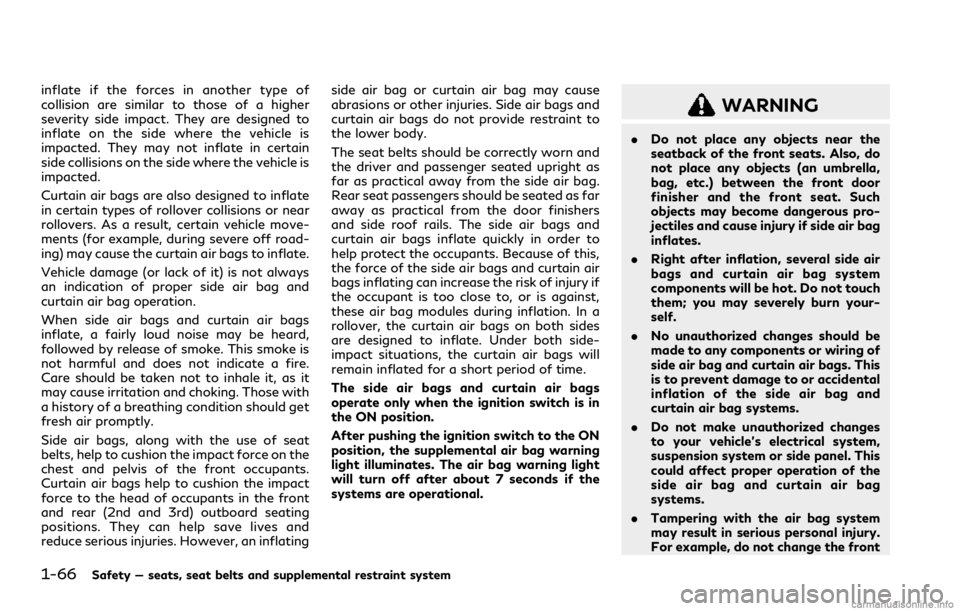
1-66Safety — seats, seat belts and supplemental restraint system
inflate if the forces in another type of
collision are similar to those of a higher
severity side impact. They are designed to
inflate on the side where the vehicle is
impacted. They may not inflate in certain
side collisions on the side where the vehicle is
impacted.
Curtain air bags are also designed to inflate
in certain types of rollover collisions or near
rollovers. As a result, certain vehicle move-
ments (for example, during severe off road-
ing) may cause the curtain air bags to inflate.
Vehicle damage (or lack of it) is not always
an indication of proper side air bag and
curtain air bag operation.
When side air bags and curtain air bags
inflate, a fairly loud noise may be heard,
followed by release of smoke. This smoke is
not harmful and does not indicate a fire.
Care should be taken not to inhale it, as it
may cause irritation and choking. Those with
a history of a breathing condition should get
fresh air promptly.
Side air bags, along with the use of seat
belts, help to cushion the impact force on the
chest and pelvis of the front occupants.
Curtain air bags help to cushion the impact
force to the head of occupants in the front
and rear (2nd and 3rd) outboard seating
positions. They can help save lives and
reduce serious injuries. However, an inflatingside air bag or curtain air bag may cause
abrasions or other injuries. Side air bags and
curtain air bags do not provide restraint to
the lower body.
The seat belts should be correctly worn and
the driver and passenger seated upright as
far as practical away from the side air bag.
Rear seat passengers should be seated as far
away as practical from the door finishers
and side roof rails. The side air bags and
curtain air bags inflate quickly in order to
help protect the occupants. Because of this,
the force of the side air bags and curtain air
bags inflating can increase the risk of injury if
the occupant is too close to, or is against,
these air bag modules during inflation. In a
rollover, the curtain air bags on both sides
are designed to inflate. Under both side-
impact situations, the curtain air bags will
remain inflated for a short period of time.
The side air bags and curtain air bags
operate only when the ignition switch is in
the ON position.
After pushing the ignition switch to the ON
position, the supplemental air bag warning
light illuminates. The air bag warning light
will turn off after about 7 seconds if the
systems are operational.
WARNING
.
Do not place any objects near the
seatback of the front seats. Also, do
not place any objects (an umbrella,
bag, etc.) between the front door
finisher and the front seat. Such
objects may become dangerous pro-
jectiles and cause injury if side air bag
inflates.
. Right after inflation, several side air
bags and curtain air bag system
components will be hot. Do not touch
them; you may severely burn your-
self.
. No unauthorized changes should be
made to any components or wiring of
side air bag and curtain air bags. This
is to prevent damage to or accidental
inflation of the side air bag and
curtain air bag systems.
. Do not make unauthorized changes
to your vehicle’s electrical system,
suspension system or side panel. This
could affect proper operation of the
side air bag and curtain air bag
systems.
. Tampering with the air bag system
may result in serious personal injury.
For example, do not change the front
Page 108 of 529

Warning indicator light (red)Warning indicator light (yellow)Vehicle Dynamic Control (VDC) off in-
dicator light
Automatic Transmission (AT) oil tem-
perature warning lightAdaptive Front lighting System (AFS)
indicator light (if so equipped)Vehicle Dynamic Control (VDC) warning
light
Automatic Transmission (AT) park
warning lightAnti-lock Braking System (ABS) warning
lightWarning indicator light (other)
Exterior light indicator
Brake warning lightAutomatic transmission check warning
lightFront fog light indicator light
Charge warning lightCheck suspension indicator lightFront passenger air bag status light
Engine oil pressure warning lightFour-Wheel Drive (4WD) warning light
(4WD models)High beam assist indicator light
Master warning lightForward Emergency Braking (FEB) sys-
tem warning lightHigh beam indicator light
Seat belt warning light and chimeLow tire pressure warning lightTOW mode indicator light
Security indicator lightMalfunction Indicator Light (MIL)Turn signal/hazard indicator lights
Supplemental air bag warning lightMaster warning light
Instruments and controls2-11
WARNING LIGHTS, INDICATOR
LIGHTS AND AUDIBLE REMINDERS
Page 112 of 529
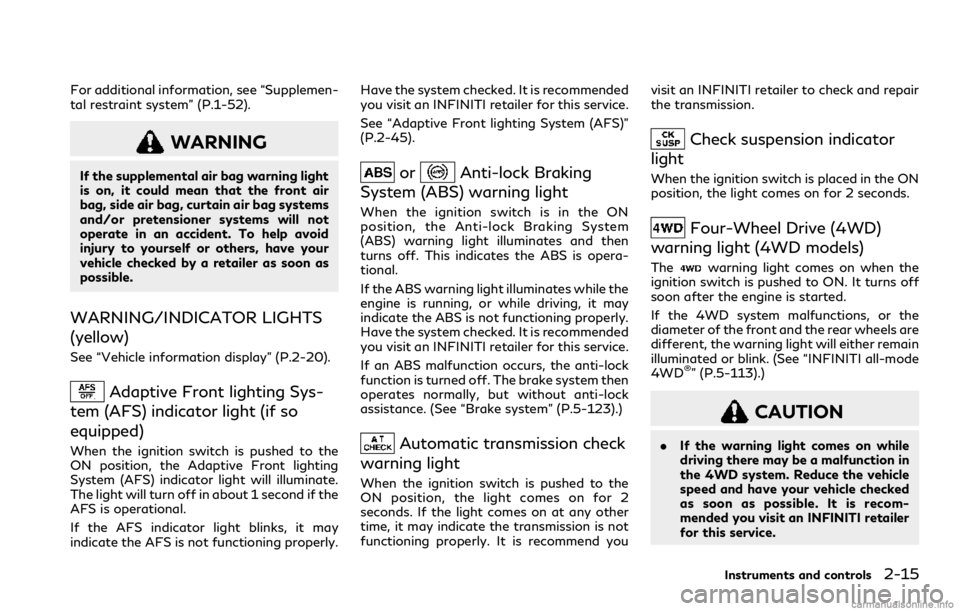
For additional information, see “Supplemen-
tal restraint system” (P.1-52).
WARNING
If the supplemental air bag warning light
is on, it could mean that the front air
bag, side air bag, curtain air bag systems
and/or pretensioner systems will not
operate in an accident. To help avoid
injury to yourself or others, have your
vehicle checked by a retailer as soon as
possible.
WARNING/INDICATOR LIGHTS
(yellow)
See “Vehicle information display” (P.2-20).
Adaptive Front lighting Sys-
tem (AFS) indicator light (if so
equipped)
When the ignition switch is pushed to the
ON position, the Adaptive Front lighting
System (AFS) indicator light will illuminate.
The light will turn off in about 1 second if the
AFS is operational.
If the AFS indicator light blinks, it may
indicate the AFS is not functioning properly. Have the system checked. It is recommended
you visit an INFINITI retailer for this service.
See “Adaptive Front lighting System (AFS)”
(P.2-45).
orAnti-lock Braking
System (ABS) warning light
When the ignition switch is in the ON
position, the Anti-lock Braking System
(ABS) warning light illuminates and then
turns off. This indicates the ABS is opera-
tional.
If the ABS warning light illuminates while the
engine is running, or while driving, it may
indicate the ABS is not functioning properly.
Have the system checked. It is recommended
you visit an INFINITI retailer for this service.
If an ABS malfunction occurs, the anti-lock
function is turned off. The brake system then
operates normally, but without anti-lock
assistance. (See “Brake system” (P.5-123).)
Automatic transmission check
warning light
When the ignition switch is pushed to the
ON position, the light comes on for 2
seconds. If the light comes on at any other
time, it may indicate the transmission is not
functioning properly. It is recommend you visit an INFINITI retailer to check and repair
the transmission.
Check suspension indicator
light
When the ignition switch is placed in the ON
position, the light comes on for 2 seconds.
Four-Wheel Drive (4WD)
warning light (4WD models)
Thewarning light comes on when the
ignition switch is pushed to ON. It turns off
soon after the engine is started.
If the 4WD system malfunctions, or the
diameter of the front and the rear wheels are
different, the warning light will either remain
illuminated or blink. (See “INFINITI all-mode
4WD
®” (P.5-113).)
CAUTION
. If the warning light comes on while
driving there may be a malfunction in
the 4WD system. Reduce the vehicle
speed and have your vehicle checked
as soon as possible. It is recom-
mended you visit an INFINITI retailer
for this service.
Instruments and controls2-15
Page 470 of 529

22,500 Miles/18 Months/36,000
Km
Standard maintenance:.Inspect Intelligent key battery.Replace engine oil and filter.Perform tire rotation
Severe maintenance:
Not Applicable. Proceed to next interval.
25,000 Miles/30 Months/40,000
Km
Standard maintenance:
Not Applicable. Proceed to next interval.
Severe maintenance:
.Inspect brake pads and rotors.Inspect steering gear and linkage.Inspect axle and suspension parts.Inspect propeller shaft (4WD models).Inspect drive shaft boots (4WD models).Inspect exhaust system.Replace engine oil and filter
30,000 Miles/24 Months/48,000
Km
Standard maintenance:.Inspect brake lines and cables.Inspect brake pads and rotors.Inspect fuel tank vapor vent system hoses.Inspect fuel lines/connections.Inspect exhaust system.Inspect steering gear and linkage.Inspect axle and suspension parts.Replace differential gear oil.Inspect propeller shaft (4WD models).Inspect transfer case oil (4WD models).Inspect drive shaft boots (4WD models).Replace engine oil and filter.Replace engine air filter (1).Replace brake fluid.Replace in-cabin microfilter.Perform tire rotation.Lubricate propeller shaft grease (4WD models)
Severe maintenance:
Not Applicable. Proceed to next interval.
(1) If operating mainly in dusty conditions, more
frequent maintenance may be required.
Maintenance and schedules9-9